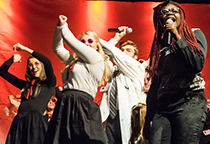Fresh ingredients add flavor in new gelato creamery
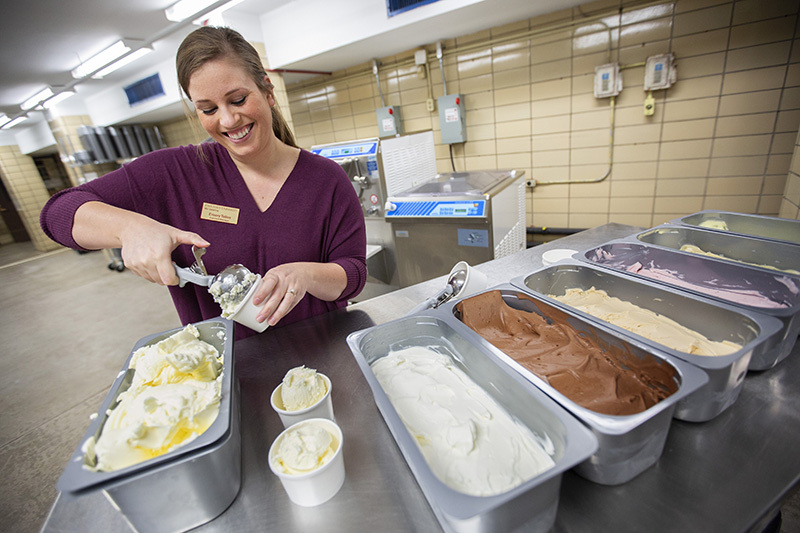
Up to 20 pans (about 30 servings in each) of gelato are produced fresh daily in ISU Dining's new creamery. Pictured behind assistant manager Emory Telios are the machines used to age the gelato base (right), then mix the ingredients (left) for about 15 minutes to produce the frozen dessert. Photos by Christopher Gannon.
When The Hub reopened last month, gelato made its campus debut. Tucked away in the basement of Friley Hall is a room ISU Dining repurposed into a creamery, where fresh gelato and sorbet are produced for the venue.
Emory Telios, an ISU Dining employee since her undergraduate years, moved from a catering supervisor role to take charge of the one-person operation. She trained with chefs at Carpigiani Gelato University, Chicago, and even won the top prize in her class with a gelato flavor fusion of lemon and black licorice.
Fresh ingredients are the key. Don't expect to see bold colors in The Hub's gelato case, a sure sign of artificial food coloring. Telios uses natural flavors, like fresh-squeezed lemons and oranges, ripe raspberries and espresso from The Roasterie coffee counter, where the gelato is served. The final product is flavorful, dense and creamy.
Telios makes up to 20 5-liter pans of gelato and sorbet each weekday. Six of the eight flavor selections are constant (for now) -- chocolate, coffee, lemon, pistachio, raspberry and vanilla. Two flavors, including a dairy-free option, rotate periodically. This week, it's orange sorbet and salted caramel gelato.
Telios said the flavor possibilities are almost limitless, and with dining and residence staff right upstairs, there are plenty of volunteer taste-testers to provide feedback on her latest creations.
"Everybody volunteers for that," said Jamie Lenz, assistant director of ISU Dining. "They're always asking when we're having another tasting."
"Maintenance requests get fixed pretty quick around here," Telios joked.
Despite record-breaking cold temperatures and Iowa's typical winter weather since The Hub reopened, the frozen desserts are gaining popularity as awareness grows. Lenz said future plans include "gelato pops" and adding gelato to more dining venues.
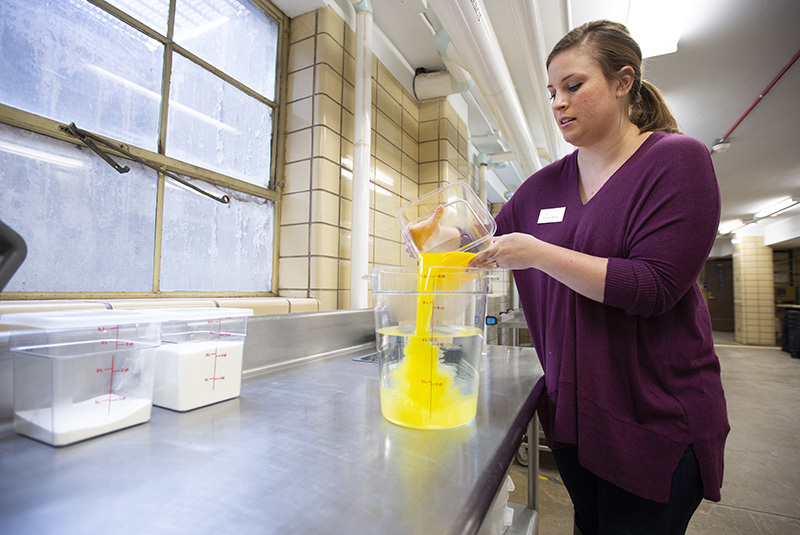
Telios mixes the ingredients for the featured sorbet flavor, using fresh-squeezed orange juice, water, sugar and a dairy-free binding powder.
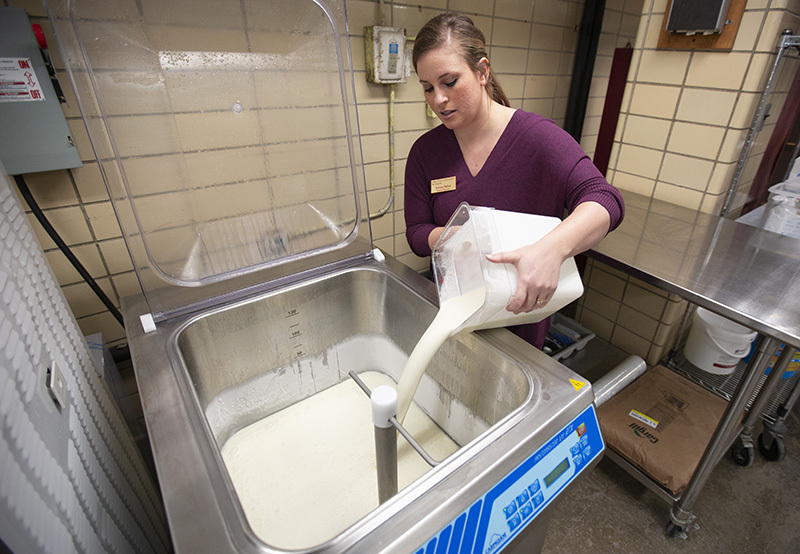
Telios prepares the gelato base, which must be aged at least 12 hours. Fresh ingredients are added to the base to create the gelato flavors.
Worktags will replace account numbers in Workday
Learn more about Workday
With Workday comes new terminology. Put "worktags" at the top of your vocabulary list because they're a fundamental part of how data and information is organized in the Workday financial and human capital management software that goes live July 1.
Instead of using account numbers, worktags will be attached to financial transactions. Worktags are identifiers -- most of them letter and number combinations -- that show where money is coming from and going, what it's being used for and who's associated with it. And they help with more than just keeping the books.
"These worktags are pretty powerful," said Kathy Dobbs, controller in the finance division. "They're not only recording financial information, they're also used for security and workflow."
Driver worktags
All financial transactions will have one of four "driver" worktags, with other worktags assigned as needed. The driver worktags designate one of four primary university accounts:
- Gifts -- ISU Foundation spending accounts and endowments
- Grants -- sponsored research funding and awards
- Projects -- capital construction projects
- Programs -- all other accounts (and the largest number of worktags)
"Those four driver worktags represent our current account structure and are going to replace our account numbers," Dobbs said.
Related worktags
Transactions also will have related worktags attached to them, such as the college (called a "business unit" in Workday), funding source, function or person assigned to the dollars. For example, a faculty member with a "grants" driver worktag would be assigned related worktags that define the college, department, funding source and function (sponsored research, for example).
Dobbs said a mapping tool is translating thousands of current accounts and subaccounts into new worktags in Workday. In most cases, employees will only need to know which driver worktag to use because most related worktags will automatically populate the transaction.
Additional worktags, such as a department detail, also may be assigned. Department detail worktags are similar to how units currently use subaccounts. They add another subset of information to transactions -- for example, a worktag that identifies highly specific data needed for a report.
Making the switch
Dobbs said employees won't have to know a long string of numbers every time they make a transaction, but they should become familiar with their new worktags. For example, a grant number being used now will be replaced by a worktag in Workday.
"We want to make it as easy as possible for campus to get away from using the Kuali Financial account numbers and start using worktags right away," Dobbs said.
Expert help
Workshops and training have been designed to introduce employees to worktags and prepare them for implementation. The WorkCyte team also featured worktags in its series of short, animated "CyByte" videos.
Local-level PIT crews and specialists on the service delivery teams will play a large part in the transition from account numbers to worktags.
"Specialists on the service teams will be knowledgeable resources and very in tune with employees to make sure they've identified the right worktags," Dobbs said. "They will fill in any missing worktags and make corrections to make sure they're aligned with the right units and funding sources."
The Conversation gives faculty another way to share expertise
Iowa State faculty have another option for sharing knowledge that extends past the classroom.
Seven months ago, Iowa State became a member of The Conversation US. The website, which has sites for several other countries, strives to provide insight on a range of topics written by academics.
"We can share the expertise and research findings of our faculty members and researchers in a way that makes sense to the average reader," said executive director of university relations John McCarroll. "These are not scholarly journal articles; these are essays."
Futurity
Since 2009, Iowa State has been a member of Futurity, a website that showcases research news in science, health, culture and the environment. Content is produced by university news staff, not academic faculty.
The Conversation
Iowa State articles published by The Conversation
Faculty from several departments have published on the platform in the past six months, some before the university was an official member. Topics include political science, engineering, economics, sociology and interior design.
The Conversation, which began in 2014, provides analytics to the author and Iowa State for each article posted on the site. It shows how many people read the essay, where it was republished and comments made across social media.
"The Conversation provides visibility for them as researchers, and it certainly provides visibility for Iowa State," said vice president for research Sarah Nusser. "It increases the public awareness of why research of any kind is important. It is really about making sure that the work we do at Iowa State gets a light shined on it."
How it works
All articles come from authors affiliated with an academic institution who have expertise on the subject. Most articles come from faculty pitches or by Iowa State News Service facilitating the initial connection. The Conversation also solicits authors through expert requests on given topics. The Conversation editors' criteria are:
- Is it of interest to a general audience?
- Is it timely?
- Is the academic an expert?
- Can the topic be covered in 1,000 words or fewer?
If the pitch is accepted, the author works with a Conversation editor -- an experienced journalist -- who will edit and offer suggestions. The writing and editing process may be on a tight timeline because much of the website's content deals with current events, but the author has final approval before the article is published.
"I have written an article for The Conversation, and they are very helpful," Nusser said. "They take your raw material and help edit it toward something that an educated high schooler could read. It is extremely beneficial."
Articles are free to read and republish, with few restrictions. The Washington Post, Time and Newsweek have republished The Conversation articles.
Getting results
Through January, Iowa State has had 17 published articles. The current contract is for one year with a decision on extension coming likely this summer.
"The feedback we have gotten from faculty members who have written for The Conversation has all been positive, and some has been extraordinarily positive," McCarroll said. "We have to look for these different ways to get the word out about Iowa State University, to share our research and knowledge, to share our achievements."
Expanding reach
Iowa State joined 56 college and university members of The Conversation. The annual fee is covered by the president’s office, the vice president for research's office, university relations and all seven colleges.
Before ISU committed, university representatives talked with peers at three larger member universities -- Michigan State, Texas A&M and Penn State.
"All three of them said it was beneficial," McCarroll said. "It doesn’t replace what your news service staff does every day, which is generate solid stories -- many about research -- but it is a good supplement to that. Because of the reach of The Conversation, it does expand beyond our normal coverage."
Nusser said The Conversation is one of several efforts Iowa State has committed to in recent years to make the public aware of scholarship and research at the university.
"Our training program has included events about communicating research to the public for several years," she said. "This is a really nice way, through a written venue, that enables researchers to provide articles that get spread out into the national and international press."
Team alignments set for finance leaders
Three finance managers have been hired and finalists will interview Feb. 11-14 for four senior human resources partner openings. The positions will oversee 11 teams of specialists in the finance and HR service delivery structures that go live July 1.
The finance managers will report to associate vice president for finance and support services Heather Paris, who oversees the improved service delivery (ISD) structure for finance. The managers and their current ISU positions are:
- Kyle Briese, fiscal officer, College of Human Sciences
- Karen Cline, business manager, business services
- Jenni Winter, fiscal and grant coordinator, materials science and engineering
Assignments are not yet set, but each finance manager will oversee a collection of ISD teams, grouped as follows:
- Aspen, hickory, juniper, sequoia, sycamore
- Birch, pine, spruce
- Dogwood, magnolia, redwood
HR interviews
The senior HR partners will report to associate vice president for human resources and strategy Dwaine Heppler, who arrived on campus this week. Finalist names will be announced one day prior to their interviews. Meet-and-greet opportunities with four candidates are:
- Feb. 11, 2-3 p.m., 3150 Beardshear
- Feb. 12, 1-2 p.m., 3150 Beardshear
- Feb. 13, 2:15-3:15 p.m., 116 Durham
- Feb. 14, 2:15-3:15 p.m., 116 Durham
Next year's 'Emerging Leaders' class is forming now
Nominations for the Emerging Leaders Academy's 2019-20 cohort are due March 1.
ELA, sponsored by the office of the senior vice president and provost, fosters leadership development of faculty and professional and scientific staff serving in leadership roles -- or those who aspire to be. During the academic year, the ELA cohort -- approximately two dozen members -- participates in monthly leadership activities led by content experts and facilitators. The activities are designed to encourage self-reflection, develop contextual skills and create leadership competencies. Participants complete modules on topics such as strategic planning, performance management, budget development and an inclusive organizational culture. Cohort members also work in teams to complete a capstone project.
The new cohort members will be selected by April 1. The academy meets monthly from September 2019 through May 2020.
Information about eligibility criteria and the nomination process is online. A nomination package includes the ELA nomination form, nominator's letter and an essay and resume from the nominee. Questions about the program or the nomination process should be directed to ELA co-directors Katharine Hensley, faculty professional development coordinator in the provost's office, or Rod Bagley, professor and chair of veterinary clinical services.
Since 2009, ELA has helped prepare a diverse group of 262 faculty and staff for leadership roles across campus.
'Varieties' tradition lives on
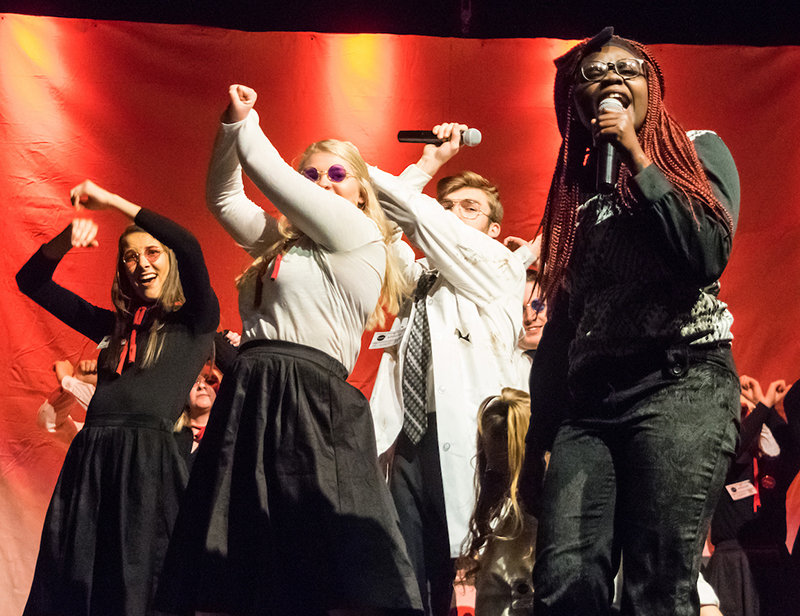
Student actors in the "Space Jam" mini-musical captured third place in the finals of the 2018 Varieties. File photo by Joe Kastner.
Following four months of creative planning and rehearsing, it's go-time for Iowa State student groups competing in Varieties, the university's annual student talent show. Semifinal performances will be held Friday-Saturday, Feb. 8-9, in the Memorial Union. Performances begin at 7 p.m. in the Great Hall; doors open at 6:30 p.m.
The Varieties format includes 20-minute mini-musicals involving several dozen actors and original song lyrics and choreography, separated by shorter performances -- solo or small group -- featuring talents such as comedy, magic, dance or instrumental music. Student emcees will introduce all of the acts, although Varieties' third competition -- among emcees -- was removed. "Tradition Lives On" is the 2019 theme students try to weave into their performances.
Two student groups will perform their mini-musicals Friday evening and three at Saturday's semifinal show. All five move on to finals. Five vignette acts will perform Friday and four on Saturday, with just four advancing to finals.
Tickets, $10 for the public and $6 for ISU students, are available through Midwestix or at the Maintenance Shop box office (11 a.m.-5 p.m. weekdays) on the MU ground floor.
Finals in two weeks
Two "finals" performances will be held Friday-Saturday, Feb. 22-23 (7 p.m.), also in the MU Great Hall. Judges will use a cumulative points system across all four Varieties performances, and winners will be crowned after the Saturday performance based on total points. Finals tickets are $12 for the public and $8 for ISU students, also via Midwestix or the M-Shop box office.
